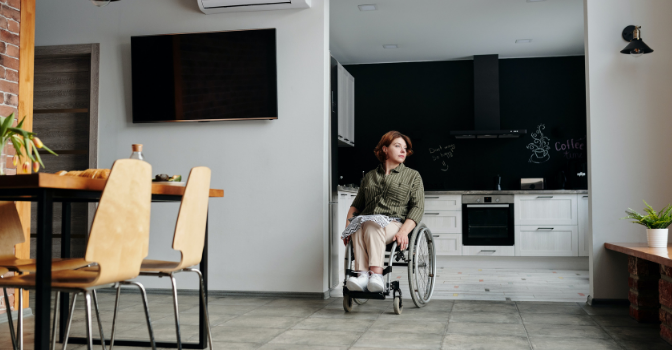New houses in Australia are set to become more accessible due to a national minimum standard that applies from mid next year.
Having a minimum accessibility standard means certain features will need to be included in homes when they are built.
The new standard is expected to create safer, more secure and livable housing for many Australians. Read on to find out more.
Core accessibility features.
Changes to the National Construction Code which take effect on 1 May 2022 will include seven features for newly built homes.
- A safe and continuous step-free path from the street entrance and/or parking area to a dwelling entrance that is level
- At least one level, step-free entrance into the dwelling
- Wider internal doorways and corridors that support more open movement between spaces
- A toilet at the ground or entry level with easy access
- A bathroom with a step-free shower
- Bathroom walls that support the future installation of grab rails
- Stairways designed to minimise injuries and enable future adaptation such as adding a continuous handrail.
Exemptions may apply for steep slopes, small lots and traditional dwelling styles.
Liveable housing design.
The new standards are based on the so-called “Livable Housing Design Guidelines” which were developed in 2010 to encourage builders and developers to create housing that meets the needs and abilities of a broader range of occupants.
Best practice guidelines for livable housing design were established and homes could be certified to a gold, silver or platinum level if certain standards were met.
The uptake of the voluntary guidelines was low so the Australian Building Codes Board has decided to make the silver standard a requirement for all new homes and apartments.
Supporting more people to live safely and comfortably.
The intention behind the change is to support more people with mild to moderate disabilities, older people, people with temporary injuries and families with young children to live safely and more comfortably.
Homes built following the rules will be more easily adaptable and cheaper to fit out as people transition through various life stages.
While the guidelines won’t accommodate the needs and abilities of everyone, it is hoped they are of widespread benefit and used in the majority of circumstances.
What happens next?
Each state and territory needs to adopt the changes into law which is expected to take place over the coming months. There may be some differences in how the code is applied from state to state.
A voluntary gold technical standard for accessible housing will also be published for builders or developers wanting to adopt more accessible features.
New disability housing on the horizon.
While we are on the topic of housing, more purpose-built disability housing is under construction in several locations across Australia.
Many new projects are underway as the NDIS stimulates investment in the development of new high quality dwellings for use by eligible NDIS participants.
Most projects fall under the banner of Specialist Disability Accommodation which is one type of housing support funded by the NDIS. It is designed for participants with extreme functional impairment or very high support needs.
In Bendigo Victoria, non-profit organisation Amicus began construction on two new SDA units in March this year. In Sutherland NSW, six new homes with state-of the-art accessibility features are expected to be ready in June 2022.
And Queensland is set to get five new purpose-built disability housing developments, consisting of 55 high quality apartments. Three of the developments are in Brisbane, one in Moreton Bay and another in Logan.
Leap in! can help.
Here at Leap in! we support thousands of Australians and their families to navigate the NDIS.
If you’re not utilising all of your NDIS Plan and want some help to make the most of your NDIS funding, get in touch with our crew. Call 1300 05 78 78, email crew@leapin.com.au or chat with us online.
Further reading
Moving out of home: All you need to know.
What is Supported Independent Living? Plus how to get your FREE SIL ebook.
Specialist Disability Accommodation.

